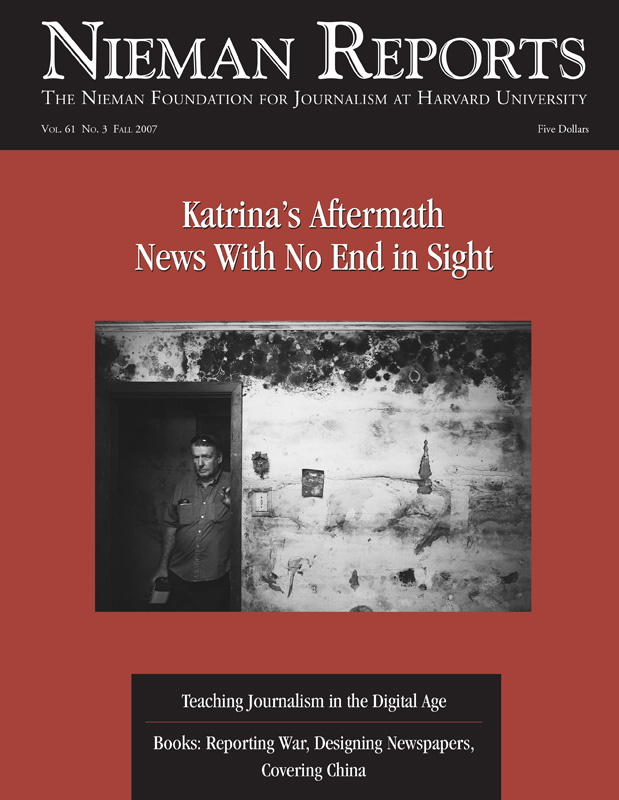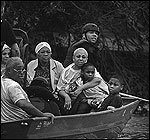Reliving August 29, 2005, or the days afterward, is not easy for me or many other people who were in New Orleans during that dark time. To stay behind while more than 80 percent of the city evacuated before Hurricane Katrina, whether as a resident, a police officer or, like me, a photojournalist, was to be forever changed, even scarred, by the horror of what was experienced and by the stories you keep buried inside.
I’m not a neophyte when it comes to covering disaster and horror.I’ve lost count of the hurricanes I’ve covered. I’ve experienced earthquake carnage and the senselessness of war. Despite my experience, Katrina crept past the emotional protection my camera lenses have faithfully provided.
I’ve struggled to explain the difference to fellow journalists. It’s similar, I’d think, to responding to an auto fatality across town only to discover my son slumped behind the wheel. Katrina altered my perspective, making it impossible to remain a distant observer. I had a strongly felt need to connect with and somehow help those I was photographing.
As a photojournalist I’m accustomed to being a first responder. But as people clung to life amid the swirling floodwaters, I found myself a sole responder.
Going Into the Flood
When Katrina blew through New Orleans that Monday morning, I was huddled with the storm team at The Times-Picayune office, watching through the windows as the wind wreaked havoc with the trees outside. The weather was nasty, but I was getting antsy. I needed to get out and start taking pictures. I knew from experience that to photograph a hurricane properly, you have to “see the wind” in the photos, and you can’t do that once the wind has stopped.
Driving my trusty old Toyota Tacoma four-wheel-drive truck, I carefully picked my way through high water, downed power lines, and trees to the French Quarter. It was more of a reconnaissance mission to check on the city’s beloved landmarks. I photographed St. Louis Cathedral as a man aimlessly walked past, praying in the blinding rain. Portions of the Superdome roof had peeled away. Since cell phones weren’t working, I returned to the office to report my findings and drop off my photo.
My editors heard that the Lower Ninth Ward, the low ground surrounded by the Industrial Canal, the Mississippi River, and the Mississippi River-Gulf Outlet, was flooding and asked if I could get there. I wasn’t sure, but I was more than willing to try. Picking my way through the four-mile stretch, I rolled over all manner of debris, even the bricks of a collapsed building in the Faubourg Marigny neighborhood. Surprisingly, I was able to drive within a couple of blocks of the St. Claude Bridge over the Industrial Canal, then waded through thigh-deep water and crossed over the canal into the Lower Ninth Ward.
I expected to see high water, but the scene stretching out beyond the bridge where I was standing caught me by surprise. Floodwater was up to houses’ eaves as far as I could see. Immediately to my right was a family of women clinging to the columns of their porch, chest deep in swirling floodwater. They were desperately waiting for help, and an elderly man on the bridge with me was frantically looking for a way to help. We considered wading across the street that separated us, or even swimming to them, but when we gauged the water depth, we knew it was way too deep and moving too fast to cross.
Above the howling winds I asked the family how long they had been trapped there. They said, “Since 8 a.m.” It was now 1 p.m. That’s when I realized they were not standing on their porch but were precariously balanced on the porch’s railing. I asked if they could get into their attic. They said they had tried unsuccessfully and now it was too late. I noticed the top of the front door was just inches above the water. I encouraged them to hang on. Surely help would arrive fairly quickly. I needed a boat, a rope, or a life ring. We had nothing but a camera between us.
As the man and I helplessly paced and watched, the women decided they would use a floating log to ferry a youngster across the current. Their plan was to push her across, and I would catch. With the swirling current between us, I knew she would never make it. So again I begged them to stay where they were, as hard as that would be. I knew it was a lot to ask, but I saw no better options.
Documenting This Moment
I also knew that my editors — and the world — needed to see what was happening here. I knew this would be a tough picture to shoot. I didn’t want to make the situation worse or add to the family’s trauma. Neither did I want it to seem that I was trying to profit from the situation. I tried to become invisible, moving to the side and diverting their attention away from me. I then quickly raised my camera. The elderly man furiously yelled for me to stop, upset that I would do such a thing. He angrily chastised and threatened me. I tried to reason with him, but this wasn’t an atmosphere for logic. I tried to tell him why this was important, that others needed to know what was happening here. My God, I thought, this is history. I told him we would sit down one day over coffee, and I’d justify the pictures.
“I’ll never have coffee with the likes of you,” he said as I clicked off a few pictures. His words cut me even deeper than he intended.
Meanwhile, the little girl was clinging to the log with a woman ready to push. I felt that being there was encouraging the attempt. Knowing that she would be swept away by the current, I wasn’t about to stand there and watch her drown, especially if only for a photo. I left.
And so my Katrina saga began. Little did I know that this ethical dilemma and ensuing debate with my conscience would become the theme of my storm coverage.
I raced back to the paper and dropped off my digital cards. From there, reporter Brian Thevenot and I headed back to the bridge, this time with an inflatable boat and a rope. As we raced down the levee road, I said to Brian, “If we have to choose between getting a story or saving a life, I’m saving lives. Are you OK with that?” He said he was, and we headed back to the family.
This time I pushed through deeper water than before, and we were able to drive over the bridge. I stopped and looked over the railing but the porch was empty. My heart sank.
By now there were several police SWAT boats working search and rescue. I yelled to them, confident that they had rescued the family. They said they had seen no one at that house.
I remembered the women’s desperation and the weariness in their eyes. In my mind I could see the little girl slip beneath the water and the others losing their composure and following her. It felt as if my chest was caving in as I assumed the worst. Could I have done more? Did I do the right thing?
The rest of our day was spent riding along in a private citizen’s rescue boat, plucking people from second-floor windows, off rooftops, and ferrying them to safety. We spent the better part of an hour snagging food and bottled water floating from a nearby grocery store to take to others. Later that night I processed my photos at the newspaper office and fell asleep on the floor.
Rowboat and a Broom
The next morning I awoke to the news of the 17th Street Canal levee break, sending water into most of the city. As the paper’s staff evacuated in delivery trucks, I escaped in a rowboat that I found on the newspaper’s dock, using a broken broom for a paddle. As I sat in the boat pondering my next move, I watched as the newspaper trucks — with most of my colleagues in them — slowly drove away through the rising water. I thought to myself that leaving alone in a rowboat was not the smartest thing I’ve ever done.
I had thoughts of the Titanic, with overloaded lifeboats rowing away from drowning passengers. I feared that I would soon find myself in the same situation. I needed some clear thinking and decided to settle my ethical questions then and there.
After a few minutes, I decided that if I saw people swimming or wading in deep water, I would help them into my boat. If they were safely out of the water on rooftops or bridges, I would leave them there for search and rescue teams. I was comfortable with that plan and started paddling. Less than five seconds later I saw a head bobbing in the water. I yelled, “Are you OK?”
The swimmer turned my way and yelled, “Ted!” It was fellow photographer Alex Brandon, with a freezer bag full of digital camera cards clinched in his teeth.
REFERRED ARTICLE
“Images Evoke Memories and Emotions”
– Alex Brandon He was evacuating the building like me but trying to get to the police SWAT headquarters just a few blocks away, where he planned to embed. We both made it to a nearby bridge ramp and decided to go our separate ways, wishing each other safety and good luck.
I paddled into the neighborhoods, not knowing where I was going or what I was going to do. I progressively found myself surrounded by people. Luckily for me, they were all high and dry. I spotted a man waving for help on the edge of an interstate ramp. I raised my camera for what promised to be a great composition. As I watched through the lens, he raised his hands in disbelief and shrugged his shoulders as if to say, “You’re going to shoot my picture but you’re not going to help me?” I decided that if I couldn’t help, neither could I shoot. I put down my camera and started rowing.
What I needed now was dry land, wherever that might be. I needed to replenish my resources: food, water and transportation. But deeper down, my primary goal was to get word to my wife, Nancy. She had evacuated to Mississippi and was surely beside herself with worry.
I rowed under a bridge where a man pleaded for help. I ignored him. I didn’t even look his way. I could hear him conspiring with others: “If we work together, we can take it from him.” They came running down the ramp trying to catch me, but I outpaced them. I remember thinking how glad I was to have been a Boy Scout.
Five hours after I left the newspaper offices, the bottom of the boat scraped the pavement of Airline Drive at Causeway Boulevard in Metairie. I walked a couple of miles to the Interstate 10 interchange and collapsed. It turned out to be a lucky spot, for a short time later rescue helicopters started landing all around me. The interchange had been designated as a triage center and eventually a pickup point for transportation out of the city.
I watched a few helicopters land with tattered victims being helped by paramedics. Finally, I summoned the strength to begin taking pictures again. By now, other media were starting to arrive. As rescuers begged for help, the photographers zoomed in tighter for the increasing drama. I disgustedly slung my cameras over my shoulder and started helping. I remember thinking, “I’m done with this. I just don’t want to do this anymore.”
But of course I couldn’t quit. The story wouldn’t let me. I hitched a ride in the back of a military dump truck headed back to the city. When we reached the water’s edge I caught a ride with a rescue boat. From there things started to improve. I was now able to help when it was needed and shoot when it was appropriate.
Later that evening, I teamed up with fellow photographer Brett Duke, who gave me a place to sleep for the night and even brewed coffee for me on a camp stove the next morning. I got out a brief call to my brother Ken in Mississippi, who could relay a message to Nancy that I was OK. That’s all she needed to know for now.
The next day Brett and I paddled his canoe through New Orleans’ Central Business District. We made our ethical decisions early. If we found people desperate for help, we would summon rescuers scouring the area. As we paddled near the Louisiana State University School of Medicine, teenage girls screamed to us for help. They could see an elderly man clinging to a chainlink fence, growing weary and about to fall. We summoned a boat nearby and shot photos as the rescuers helped him into their boat. I was feeling better about myself.
As we paddled back near the LSU balcony, the young girls cheered us. “You saved a life,” they swooned. “No, you saved a life,” we told them. Their voices made the difference. This is how I wanted to work. I was happy to be able to help and get photos, too.
Thinking About My Photos
Wednesday night, I joined five other photographers as the city began to fall into chaos. As we woke Thursday, there were rumors of a riot at the Morial Convention Center. Fully expecting full-bore violence, we warily approached the scene. As we were spotted, people began crazily running toward us but, to our surprise, they were screaming, “The press is here, the press is here.” I’ve never been greeted in such a way. We each were grabbed by the arm and ushered around the dramatic scene. Angela Perkins grabbed my arm.
“You’ve got to see this; you’ve got to see that,” she said as she took me by dead bodies lying on the street’s median. I was escorted past rancid restrooms, squalid sleeping quarters, and thousands of hopeless people. As I walked amid the mass of people, Angela became more emotional about her plight and suddenly dropped to her knees, clasped her hands in prayer and screamed, “Help us, please!” Brett Duke, Melissa Phillip of The Houston Chronicle, and I were all shooting furiously.
As Brett and I analyzed the situation later, we wondered to whom was she praying. I’m a very religious man, but I realized she was not praying to God. She was praying to the world through our lenses.
At this point, I realized that my ethical dilemma had come full circle. The power of the camera in this moment was much more intense than anything I could have done for them.
During the past two years, I’ve analyzed my photo coverage of the storm and decided that the pictures I made were shot because I couldn’t help in any other way. I mostly shot pictures in self-defense. It was the only thing I could do.
Months after the storm, for a Thanksgiving Day feature, editors proposed a Living story allowing victims to thank their rescuers, titled “Savior in the Storm.” They wanted to tell the story through the dramatic photos we had shot. We each turned in a photo we wanted included in the package. I submitted the photo of the women on the porch, not because it was my best picture, but because I wanted to learn their fate. Would they be listed with the victims of the storm or did they manage somehow to escape the floodwater?
Writer Maria Montoya was given the task of tracking down the women and found them rattled but safe in Houston. Teenagers had rescued them in a fishing boat while I was racing back from the paper.
I couldn’t wait to talk to them. I had so many demons to quell. When I finally got them on the phone, Audrey Walton confirmed what I knew she had been thinking. She asked me, “What we couldn’t understand was why you left us?”
“I want you to know,” I said, “I came back with a boat and a rope.”
“Oh,” she said. “I didn’t know that.”
We had a pleasant conversation after that and, as I was telling her goodbye, she said, “I’d like to ask a favor. If you can, can we get a copy of the picture? We’d like to have one to keep.”
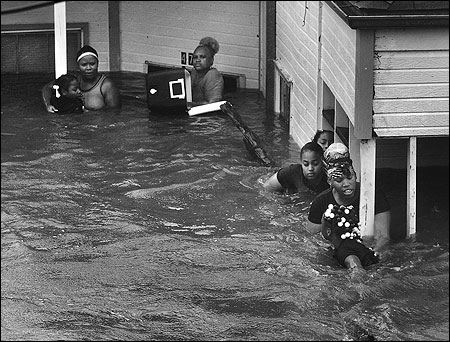
Family members cling to posts on their front porch as rising floodwaters force them to evacuate their home on St. Claude Avenue in the Lower Ninth Ward. They had tried to get into their attic space but said the floor wouldn’t hold them. Floodwaters raging down St. Claude had prevented rescuers from reaching them. August 29, 2005. Photos by Ted Jackson/The Times-Picayune.
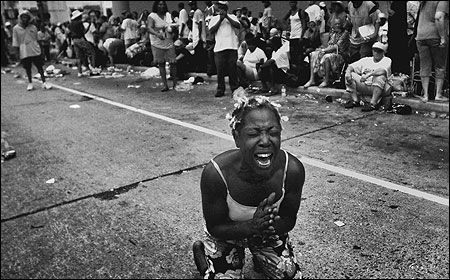
Angela Perkins pleaded with the world with her cry, “Help us, please.” September 1, 2005.
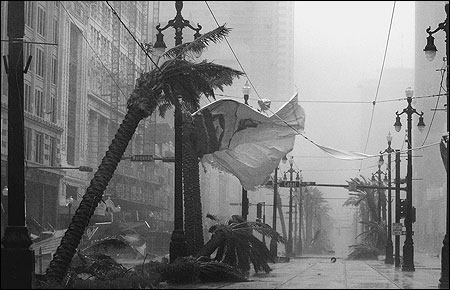
Palm trees bend and break in Hurricane Katrina’s winds as a banner from a billboard flaps from a Canal Street lamppost. August 29, 2005.
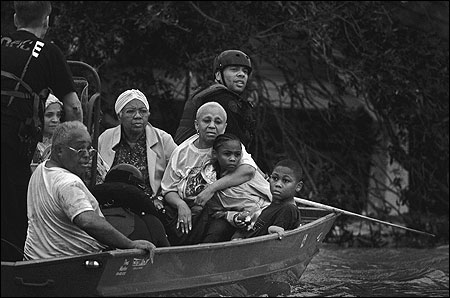
Evacuees rescued from their homes in the flooded Lower Ninth Ward express their anxiety. August 29, 2005.
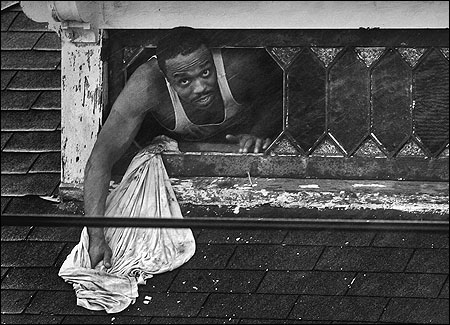
During the height of the storm, a man uses a T-shirt to attract attention from rescuers from his attic window in the Lower Ninth Ward. Rising floodwaters forced him and his family, including small children, into their attic. August 29, 2005.

Clinging to his puppy, the resident of a burning home on Columbia Street in New Orleans walks away while smoke and water fill the air. September 6, 2005.
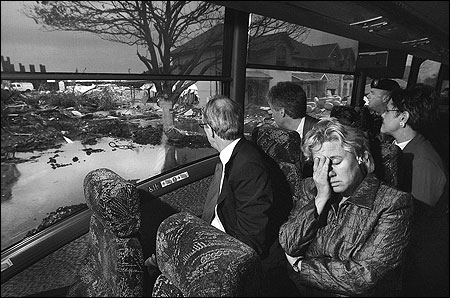
The Netherlands Ambassador Boudewijn van Eenennaam looks out the tour bus window as it passes the 17th Street Canal repair work as U.S. Senator Mary Landrieu succumbs to the moment. Landrieu led the tour through areas of Orleans and St. Bernard Parishes devastated by Hurricane Katrina. November 28, 2005.

The corpse of Alcede Jackson is reverently laid out on his front porch at 4732 Laurel Street in Uptown New Orleans, covered with a blanket and held down by slate. The body was left abandoned for 17 days with an epitaph on a poster board, “Rest in peace in the loving arms of Jesus.” September 5, 2005.
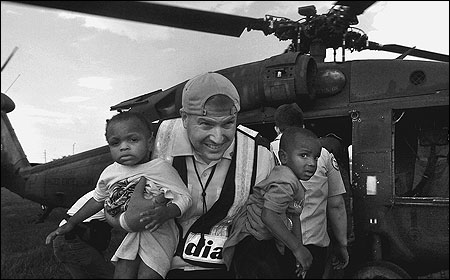
An EMT helps children from an Army Black Hawk helicopter as they arrive at the Interstate 10 interchange staging area. August 29, 2005.
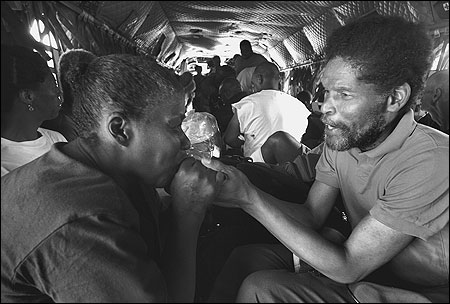
Connie Falls kisses Clarence Robinson’s hands as they lift off in an evacuation helicopter at the Morial Convention Center headed for Armstrong Airport. September 5, 2005.

A man with his baby cries out over the body of an old man who died in a chair on Convention Boulevard. Refugees crowded into the Morial Convention Center, with no authority supervising or supplying food, water, or any other essentials. September 1, 2005.
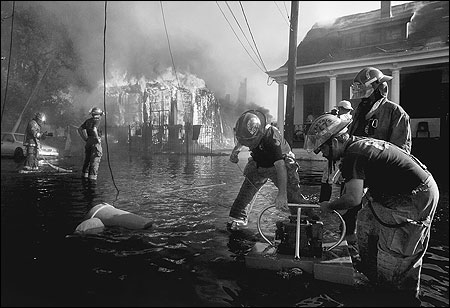
Firemen struggle to start a small floating pump to fight a raging inferno, attempting to keep it from spreading to the next house. “It’s the best we can do,” one fireman said. September 6, 2005.
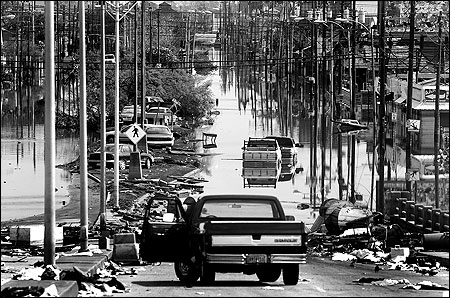
Putrid waters inundate many streets of New Orleans, including Broad Street, as seen from the Broad Street Overpass. September 12, 2005.
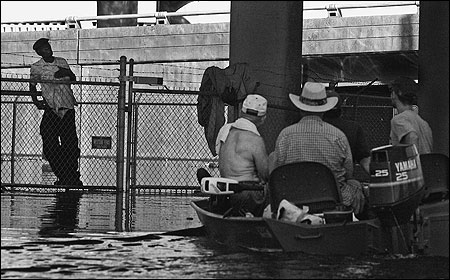
An elderly man clings to a chainlink fence as a rescue boat approaches to help him. August 31, 2005.
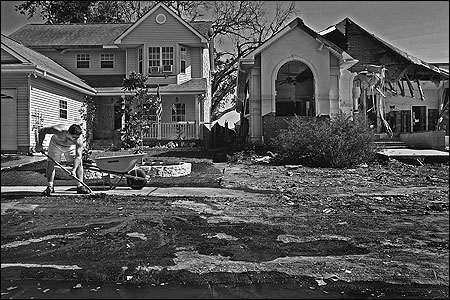
John Nemeth works to get his yard in shape on Hay Place, just 200 yards from the breach of the 17th Street Canal, while his next door neighbor’s house lies in ruin, untouched since the storm. August 8, 2006.
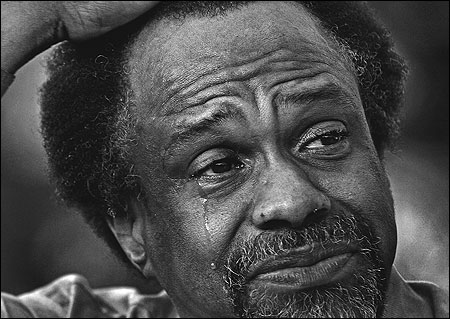
Robert Green, Sr. of the Lower Ninth Ward recounts the horrors of surviving Hurricane Katrina. His traumatized family moved higher and higher onto the roof until they were all huddled together. Robert and his brother Jonathan shielded the children and their frail mother from the howling winds and stinging rain. Once the winds died down, Jonathan said, “Mamma didn’t make it.” She died sometime during the long morning. As he said this, he told Robert that her dying words were, “I’m going to take care of Nai Nai.” Nai Nai Green, who was three years old, had died that night when she fell off the roof into the swirling waters. August 15, 2006.


